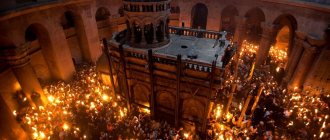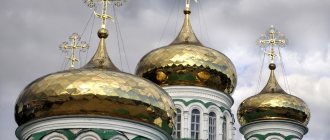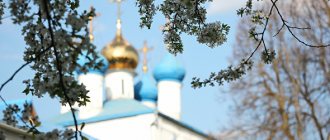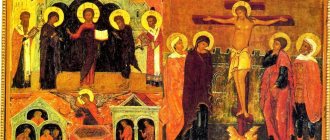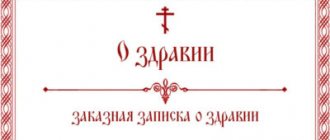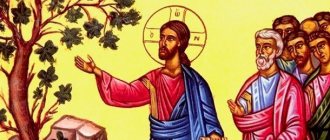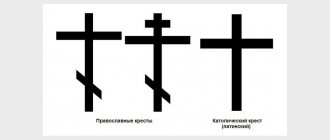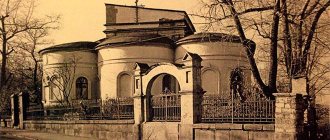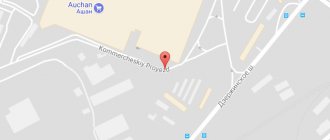Any Christian, from the ceremony of Baptism until death, is obliged to wear a symbol of faith, an unchangeable attribute of the Orthodox faith, a pectoral cross. It is called that because it is not supposed to be worn over clothing, but on the body itself. The eight-pointed one resembles the one on which Jesus Christ was crucified for the fall of people. Legends say that there are many nuances when choosing a wooden cross. You should respect church symbols and consider them not only decorations, but also a symbol of a person’s faith in the Lord.
Men's wooden cross
A wooden cross for men, which is always nearby, constantly reminds of Christ and the Almighty, helps strengthen spirituality, gives a person strength and protects him from the evil of Satan. During the rite of Baptism, a person renounces the Devil and expresses his readiness to serve the Lord throughout his life. Ancient crosses made of wood often resemble a four-pointed shape. Christians considered it a symbol of faith in God. In ancient times, Jesus was depicted with the twelve apostles, and the cross was also depicted purely symbolically. Over time, when the eight-pointed cross appeared, the appearance of the attribute changed. However, even now you can see a four-pointed shape, and eight-pointed ones are depicted inside them. Quite often, Golgotha and the head of Adam, a spear and a cane were depicted on the cross.
Birch in the shape of a cross. Believers considered her appearance a miracle. Anzersky Island
“Here the aspens are as light as birches, but the birches are not so light. The burning tears of the fallen prisoners burned the trunks of all the birch trees.” ( Fyodor Sukhov . Solovki. 1991.)
Vladyka Laurus bowed to the Anzer miracle and took the staff to America as a souvenir.
In the summer of 2001, Archbishop Laurus of Syracuse and Trinity arrived from New York to Solovki. “I remember visiting the Golgotha-Crucifixion monastery on the island of Anzere. Next to this monastery, the Lord showed a miracle: there, as if in memory of all the Solovetsky new martyrs and confessors, a birch tree grew in the shape of a cross. On the island of Anzere, the ruler picked up a stick, which he used as a staff during the pilgrimage. Upon arrival in the USA, this stick was processed, varnished and it turned into a real staff, which the Bishop keeps as a memory of Solovki.” ( Deacon Pavel Ivanov . Pilgrimage of Archbishop Laurus to Russia. “Orthodox Life” 10.2001)
Cross-shaped birch. 2002. Photo by Alex Budovsky. USA.
“But for some reason this landmark of Anzer Island is not mentioned in the books “Anzer and Its Shrines” and “Solovetsky Monastery.” But you will find it in many sets of Solovetsky postcards. This is a kind of Golgotha cross - a cruciform birch tree that grew on the slope of Mount Golgotha near the unmarked graves of Solovetsky prisoners. Almost all the crosses on the archipelago were used for firewood at one time, and according to legend, this is how God marked the place. In 2002, you could still approach it and touch the bark. "(Alexey Budovsky)
Human evidence
“...it stands on a hill, but around it there are not graves, but holes from graves... local residents say that in the early nineties “people in civilian clothes” arrived and dug up all the remains and took them away. The tracks were covered. So, that year, someone cut off a large piece of birch bark from this birch tree at its base, in a circle. So she could have already died...” ( Svetlana Konysheva. From correspondence. Moscow-Toronto. 04/21/2006)
A magnificent photo report from Solovki and a laconic caption to the picture: “A cross-birch tree that grew on the site of mass graves of prisoners of the Solovetsky camp.” ( Svetlana Konysheva . Solovetsky archipelago. A monastery is being revived on an island in the White Sea. Nezavisimaya Gazeta. No. 6, 04/06/2005)
“On the Solovetsky Islands there was a holy thousand ten-meter wooden crosses of worship. Holy thousand tons of crosses. The Bolsheviks destroyed everything, for firewood, or so, as a warning, after the closure of the monastery in 1923. Now the crosses are being made anew. We have already made five crosses, three of which stand in Norway at the Russian Pomeranian cemetery. Soon such a cross will be placed in front of the monastery in the harbor, on the island. The cross weighs one ton, is ten meters long, and has already been carved.
The confessor for the governor and dean of the monastery is Father John (Krestyankin) from the Pskov-Pechersky Monastery. The vicar and the dean come to Father John to confess once a year. He also approves the sketches of the crosses and altar that are being cut for the St. Nicholas Cathedral in the Solovetsky Monastery. There is one cross on Solovki, which he did not approve.
Cross-shaped birch. 2002. Photo from a postcard.
“This year I saw that the tree was already surrounded by a simple fence in order to prevent particularly zealous pilgrims who strip the birch bark as a souvenir.” (Alex Budovsky. USA. 2002.)
On Anzersky Island there was a monastery, a church, and a fraternal building. Under the Bolsheviks, there was a camp with a huge cemetery nearby. A birch tree with a cross grew among the graves.” ( Vladislav Dorofeev . School of Angels. St. Petersburg almanac “Verse Libre”, 19??)
“When leaving the temple, a magnificent view of the sea and islands, His beautiful creation, felt like peace sent by the Lord. After standing and admiring it, we began to descend from the mountain, and here before us was a new miracle - a birch tree in the shape of a cross. A tall straight trunk goes up, and two strong branches are spread out to the sides, like the crossbar of a cross. Many man-made worship crosses, skillfully carved from wood, were once erected on Solovki. During the ELEPHANT years they were all destroyed. And so, by the Providence of God, a cross not made by hands was erected...
Now on the Big Island a cross-carving workshop has been revived, in which crosses are made according to ancient designs. They are installed on the islands of the archipelago in memorable places of worship. ( Olga Lashkova . Anzer is an island of sorrow and joy. The source is lost. July 2001.)
“...an amazing birch tree grew on the mountainside, its branches forming a completely regular cross. The monks say that no one has ever trimmed this birch tree, and consider its appearance a miracle. The rumor about this birch has already spread very far, many people ask if I have seen it. Of course I saw it. It really is a straight cross, as if specially carved by an unknown master. Truly, this is a miracle, divine and natural.” ( Ilya Sleptsov. Golgotha-Crucifixion Monastery needs help. “Wanderer”, 2004)
Sergei Tonkonogov, photographer: “For me, for example, miracles not made by hands look much more convincing. Look here. See this birch tree in the shape of a cross. From the outside, of course, it seems like nothing special. Different trees grow on the ground... But here's the background. In the place where it grows (Anzer Island of the Solovetsky Archipelago - author) in the twenties, monks who were shot by the Bolsheviks or who died in hard labor were buried. Of course, they didn’t put up crosses. And those that suddenly appeared on the graves were immediately demolished. That’s when nature itself put this cross here.” ( Alexey Mikheev. Objective incredible. MK-Health. 46. 06/01/2004)
Polina Struzhkova, Moscow International Film School, 2002: “...on Anzer... there is a birch tree in the shape of a cross. She grew up when crosses were burned on Solovki in the 20s. Now she’s probably 6 meters tall.”
Cross-shaped birch. 2014.
A curiosity - trees that have grown to look like a cross
Another curiosity is trees that have grown to look like a cross with a tail. The bizarre branching of the trunk evokes an association with a devil’s tail inappropriate for a cross, which has become an irritating factor for adherents of the Orthodox holiness of the islands in the 21st century. The “tail” destroyed a well-known pine tree that grew in a protected forest near the road to Cape Pechak. The tree was cut down in 2013; a stump about a meter in diameter remained.
“The birch on Anzer Island, on the slope of Golgotha, also has the shape of a cross, but due to the absence of a “tail” the fate of this tree is happier. The birch tree was fenced off and shown to pilgrims as a miracle confirming the holiness of the place. However, there is a completely prosaic explanation for this tree branching, unusual for birches.
The birch-cross on the Anzer Golgotha is relatively young. Judging by the research of specialists from the dendrochronological laboratory of the Institute of Geology of the Russian Academy of Sciences, its first growth ring was formed in 1953. When the islands opened to the public in the early 1960s, some of the skilled sixties, like former prisoner Yu.I. Chirkova, turned the birch into a living monument. The biologist cut the branches of the young tree so that they formed a cross, which could not appear naturally on the birch.” ( Yuri Brodsky. “Solovki. Labyrinth of Transfigurations.” Moscow. Novaya Gazeta, 2017)
Symbolism of letters.
You can often see the letters IНЦI on wooden crosses. They mean Jesus of Nazareth, King of the Jews. Usually the abbreviation can be seen on large-sized items; they remind us that Jesus had to pay for human sins with blood, but he willingly accepted the punishment. The inscriptions TsR SLVY IS XS SN BZHIY mean: “King of Glory Jesus Christ the Son of God.” You can also see the inscription NIKA, which shows that Christ managed to defeat death and subsequently resurrect in order to show people that miracles happen if the Creator wants it. The letters MLRB may be present, which stands for how Paradise was once located at the place where Jesus was executed.
Origin of the life-giving tree
The history of the Life-giving Cross of the Lord is based on legends about the life-giving tree on which Jesus was crucified, but which still gives miracles of healing and liberation.
The Bible does not answer the question of what kind of wood was used to make the instrument of death on which Christ was crucified. In the Gospels it is already being prepared as an instrument of crucifixion.
Apocryphal sources store a lot of interesting reliable data about the origin of the legendary tree.
According to the legend of the Bogomils, a Christian movement of the 5th century that came from Bulgaria, the tree of paradise of good and evil fell into three parts during the expulsion of Adam and Eve. The central part remained in the Garden of Eden, and subsequently the Cross was made from it for the crucifixion of Christ.
According to the Golden Legend, Adam's son Seth went to the gates of the Garden of Eden with a request to give him oil to anoint his dying father. Archangel Michael refused him, saying that this oil was closed for 5.5 thousand years before the time of the birth of Jesus, but presented Seth with a branch from the tree of good and evil. Seth did not find his father alive; a wreath was woven from a branch of the legendary tree and placed on Adam’s head during burial.
Death of Adam, artist - Pierro Dela Francesca
From this branch subsequently grew a tree, cut down by the servants of King Solomon to build the temple in Jerusalem. Due to the discrepancy in size, it was used as a support for a bridge.
The Queen of Sheba, who had the gift of prophecy when visiting King Solomon, stopped near the bridge and knelt in front of the historical tree. According to her, this tree is destined to become an instrument of death for the Savior of the world, after which the Jews will face ruin.
King Solomon knew the Queen of Sheba and her gift of vision well. The prediction seriously frightened him. By order of the king, the tree was dismantled from the bridge and buried.
The wood of this timber was subsequently used to build a pool in Bethesda, whose water attracted the crippled with its healing qualities.
When Jesus was arrested, this tree emerged from the foot of the pool, a cypress from which the trunk of the Life-Giving Shrine was made, the crossbars were made of pine and cedar.
Important! The history of the life-giving Cross of the Lord formed the basis of the Feast of the First Savior, which is celebrated on August 14. It is popularly known as Honey Spas.
Modern crosses
It is worth noting that the image of the crucifixion, which appeared relatively recently, does not entirely correspond to the canons of the church. After all, the pectoral cross becomes a kind of icon, and it is needed precisely for reading prayers. Wearing icons on a person’s body, hiding it from prying eyes, carries danger, because it is not used for its intended purpose. The cross is a symbol, and the Crucifixion is an image. Priests are supposed to wear it with the image of Jesus crucified on the cross, but they wear it over their clothes and put it on display for everyone to see. Well, on the cross, which is intended to be worn under clothing, there should be no crucifix.
Women's cross
The Old Believers still clearly distinguish between men's and women's products. The female cross should be wooden and smooth, there should be no sharp corners. It is desirable to have an image of a vine around it, which shows the tenderness, affection, obedience and fertility of a woman. It is recommended to wear it on braided threads or braid, so that you can not take it off if necessary, but take it in your hands and overshadow yourself with a sign. When purchasing a symbol with a crucifix, you must ensure that it is created in accordance with all canons and rules. You should not choose in favor of the crying expression on the face of Christ for those suffering and tormented. After all, the nature of his body is divine, he was ready to joyfully save humanity and experience torment, knowing that very soon he would ascend to heaven, to his father and Creator.
